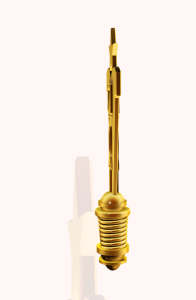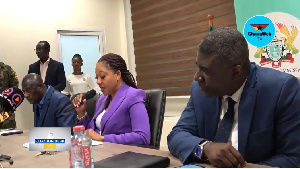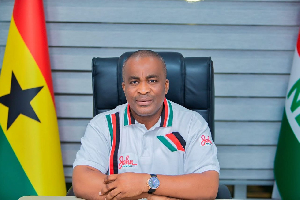Mr. Kwame Addo-Kufuor, President of the Ghana Chamber of Mines, is optimistic that gold output from producing member-companies will increase by some 400,000 ounces this year.
He told the B&FT that gold output is expected to increase from 2.4 million ounces recorded in 2016 to 2.8 million ounces in 2017, as planned investment projects are expected to boost production.
“The producing member-companies of the Chamber will continue to invest in their operations to ensure a sustainable mining sector. Planned projects of member companies are expected to have significant impacts. These investments are expected to translate into growth in production in the ensuing years,” he said.
Mr. Addo-Kufuor, who was speaking during a courtesy call on the Minister of Lands and Natural Resource--John Peter Amewu—by the executives of the Chamber of Mines, confirmed that investments planned in the short to medium-term include: Subika Underground, Ahafo North, Ahafo Mill Expansion, Goldfields Tarkwa and Daamang Mine, Esaase Phase II development at Asanko, and the turnaround of Obuasi.
These projects, costing billions of dollars, is expected to grow the industry and support Ghana’s position as a major gold producer.
Underscoring the Chamber’s readiness to collaborate with the government to roll out initiatives that would be mutually beneficial to the country and the mining industry, Mr. Addo-Kufuor said there were many opportunities in the mining industry and minerals value-chain to create a viable and competitive industrial sector.
“We believe that there is more scope for accelerated economic development on the back of the minerals and mining industry,” he said.
The mining industry has been the leading contributor to the nation’s fiscal purse, except in 2015. Its contribution to direct domestic revenue improved from GH¢ 1.3 billion in 2015 to GH¢ 1.6 billion in 2016, representing a growth rate of 23 percent.
“Aside from its significant role in improving the balance of payments position, particularly in the context of an International Monetary Fund (IMF) Extended Credit Facility Programme, it is also worth noting that it was a major contributory factor for the deceleration in the depreciation of the local currency relative to other traded currencies,” Mr. Addo-Kufuor said.
Regarding, corporate social investment projects, producing member-companies of the Chamber invested US$ 17.09 million in 2015 in a variety of projects which are potent and strategic tools for complementing the government’s efforts to accelerate development in mining areas and improve the well-being of the community members.
“It must be emphasized that most of these projects resulted in job creation. For instance, Golden Star Bogoso Prestea Limited outsourced the hauling of its ore from the pit to the mill to a consortium of local vendors, a contract worth US$2.8 million in 2015.
AngloGold Ashanti’s flagship CSI project, Malaria Control Programme, did not only significantly reduce morbidity associated with the malaria causing vector but was also replicated nationally with outstanding results.
Gold Fields Ghana Foundation provides support to teachers in its catchment area to improve the outcomes of teaching and learning.
Similarly, Newmont Ahafo Development Foundation constructed a fully-furnished library for the people of Susuanso. Both the Ahafo and Akyem foundations are seen as world class social impact initiatives which have significantly improved livelihoods in the respective communities
Furthermore, Perseus Mining (Ghana) Ltd. handed over a US$ 30 million resettlement project to a community in its catchment area. As well, Chirano Gold Mines continues to contribute to the improvement of health outcomes in its operational area through the Malaria Control Programme,” he said.
Observing that the proportion of funds that is injected into mining communities for development, Mr. Addo-Kufuor said the phenomenon is the result of poor infrastructure development in mining communities, despite their contribution to the national income.
He described the situation as disappointing, since mining companies pay the right amount of revenue to government to help improve mining communities.
“In 2016, mining companies paid mineral royalty in the amount of GH¢550 million to the government. But the proportion of the total mineral royalty which goes directly to the 14 District Assemblies in whose jurisdiction mining takes place represents only 4.95 percent of mineral royalty payments.
This implies that only GH¢27 million is expected to be returned to district assemblies for development. This amount is woefully inadequate for the stimulation of infrastructural development in the mining communities,” he said.
He pledged the Chamber’s support for the new Minister to enable him implement policies and programmes to speed-up the growth and development of the mining sector.
On his part, Mr. Amewu expressed government’s commitment to addressing holistically the menace of illegal mining.
“Mining in the forest and in water bodies must be stopped. We will take the fight to the illegal miners. We, therefore, need the Chamber’s collaboration,” he said.
Mr. Amewu said government policies in the mining sector are geared towards enhancing growth and expressed the hope that by working together the country could achieve the benefits from the sector.
“We can achieve the benefits of the mining industry if we work hand-in-hand with the mining firms. My doors are opened for your suggestions,” he said.
Click to view details



Business News of Thursday, 23 February 2017
Source: B&FT Online

















